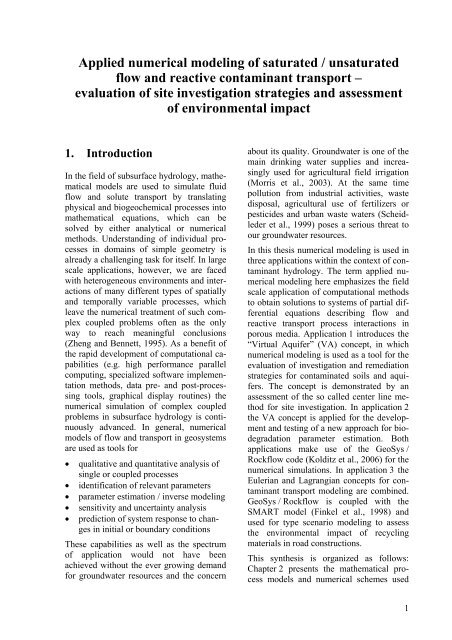Applied numerical modeling of saturated / unsaturated flow and ...
Applied numerical modeling of saturated / unsaturated flow and ...
Applied numerical modeling of saturated / unsaturated flow and ...
Create successful ePaper yourself
Turn your PDF publications into a flip-book with our unique Google optimized e-Paper software.
<strong>Applied</strong> <strong>numerical</strong> <strong>modeling</strong> <strong>of</strong> <strong>saturated</strong> / un<strong>saturated</strong><br />
<strong>flow</strong> <strong>and</strong> reactive contaminant transport –<br />
evaluation <strong>of</strong> site investigation strategies <strong>and</strong> assessment<br />
<strong>of</strong> environmental impact<br />
1. Introduction<br />
In the field <strong>of</strong> subsurface hydrology, mathematical<br />
models are used to simulate fluid<br />
<strong>flow</strong> <strong>and</strong> solute transport by translating<br />
physical <strong>and</strong> biogeochemical processes into<br />
mathematical equations, which can be<br />
solved by either analytical or <strong>numerical</strong><br />
methods. Underst<strong>and</strong>ing <strong>of</strong> individual processes<br />
in domains <strong>of</strong> simple geometry is<br />
already a challenging task for itself. In large<br />
scale applications, however, we are faced<br />
with heterogeneous environments <strong>and</strong> interactions<br />
<strong>of</strong> many different types <strong>of</strong> spatially<br />
<strong>and</strong> temporally variable processes, which<br />
leave the <strong>numerical</strong> treatment <strong>of</strong> such complex<br />
coupled problems <strong>of</strong>ten as the only<br />
way to reach meaningful conclusions<br />
(Zheng <strong>and</strong> Bennett, 1995). As a benefit <strong>of</strong><br />
the rapid development <strong>of</strong> computational capabilities<br />
(e.g. high performance parallel<br />
computing, specialized s<strong>of</strong>tware implementation<br />
methods, data pre- <strong>and</strong> post-processing<br />
tools, graphical display routines) the<br />
<strong>numerical</strong> simulation <strong>of</strong> complex coupled<br />
problems in subsurface hydrology is continuously<br />
advanced. In general, <strong>numerical</strong><br />
models <strong>of</strong> <strong>flow</strong> <strong>and</strong> transport in geosystems<br />
are used as tools for<br />
� qualitative <strong>and</strong> quantitative analysis <strong>of</strong><br />
single or coupled processes<br />
� identification <strong>of</strong> relevant parameters<br />
� parameter estimation / inverse <strong>modeling</strong><br />
� sensitivity <strong>and</strong> uncertainty analysis<br />
� prediction <strong>of</strong> system response to changes<br />
in initial or boundary conditions<br />
These capabilities as well as the spectrum<br />
<strong>of</strong> application would not have been<br />
achieved without the ever growing dem<strong>and</strong><br />
for groundwater resources <strong>and</strong> the concern<br />
about its quality. Groundwater is one <strong>of</strong> the<br />
main drinking water supplies <strong>and</strong> increasingly<br />
used for agricultural field irrigation<br />
(Morris et al., 2003). At the same time<br />
pollution from industrial activities, waste<br />
disposal, agricultural use <strong>of</strong> fertilizers or<br />
pesticides <strong>and</strong> urban waste waters (Scheidleder<br />
et al., 1999) poses a serious threat to<br />
our groundwater resources.<br />
In this thesis <strong>numerical</strong> <strong>modeling</strong> is used in<br />
three applications within the context <strong>of</strong> contaminant<br />
hydrology. The term applied <strong>numerical</strong><br />
<strong>modeling</strong> here emphasizes the field<br />
scale application <strong>of</strong> computational methods<br />
to obtain solutions to systems <strong>of</strong> partial differential<br />
equations describing <strong>flow</strong> <strong>and</strong><br />
reactive transport process interactions in<br />
porous media. Application 1 introduces the<br />
“Virtual Aquifer” (VA) concept, in which<br />
<strong>numerical</strong> <strong>modeling</strong> is used as a tool for the<br />
evaluation <strong>of</strong> investigation <strong>and</strong> remediation<br />
strategies for contaminated soils <strong>and</strong> aquifers.<br />
The concept is demonstrated by an<br />
assessment <strong>of</strong> the so called center line method<br />
for site investigation. In application 2<br />
the VA concept is applied for the development<br />
<strong>and</strong> testing <strong>of</strong> a new approach for biodegradation<br />
parameter estimation. Both<br />
applications make use <strong>of</strong> the GeoSys /<br />
Rock<strong>flow</strong> code (Kolditz et al., 2006) for the<br />
<strong>numerical</strong> simulations. In application 3 the<br />
Eulerian <strong>and</strong> Lagrangian concepts for contaminant<br />
transport <strong>modeling</strong> are combined.<br />
GeoSys / Rock<strong>flow</strong> is coupled with the<br />
SMART model (Finkel et al., 1998) <strong>and</strong><br />
used for type scenario <strong>modeling</strong> to assess<br />
the environmental impact <strong>of</strong> recycling<br />
materials in road constructions.<br />
This synthesis is organized as follows:<br />
Chapter 2 presents the mathematical process<br />
models <strong>and</strong> <strong>numerical</strong> schemes used<br />
1

















